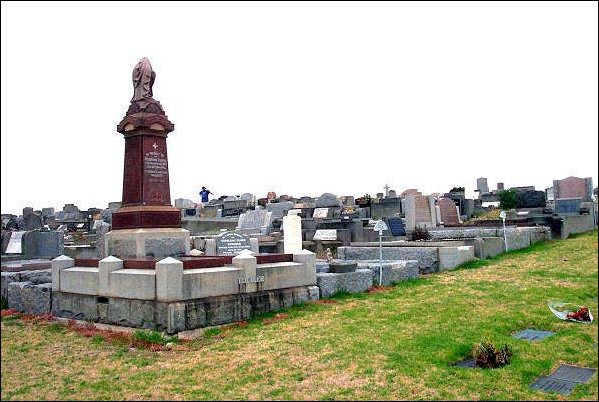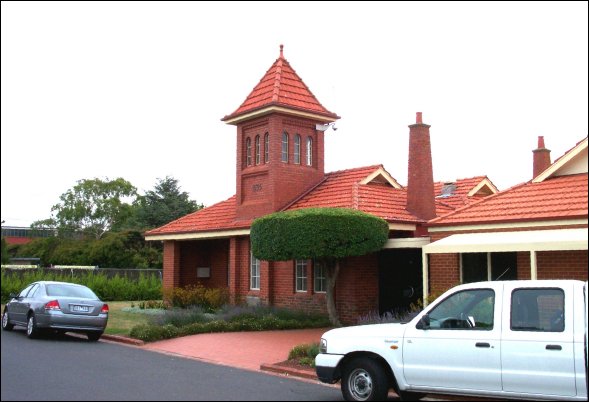A Crematorium at Cheltenham: A Historical Perspective

Graves at the New Cheltenham Cemetery 2004.
No other form of disposing of the dead has seen a greater shift in social attitudes than cremation, nor elicited a wider degree of emotions ranging from abhorrent and anti-Christian to one of universal acceptance to all but a small portion of society.
When the first English crematorium was established at Woking, Surrey (England) in 1851 it was only a matter of time before the colonies of Australia followed suit. [1] The first documented case of a cremation performed on a European in Victoria was April 1895 on the foreshore of Black Rock-Half Moon Bay, much to the disgust of the people, the press and the politicians. [2]
After many failed attempts during the 1890's, the practice was legalised in Victoria by an Act of Parliament in 1903. [3] It was introduced as a private members bill by the redoubtable Frederick Grimwade (St Kilda Cemetery). However, the first 'legal' cremation in Victoria did not take place until April 13, 1905 when at the Springvale Necropolis a makeshift hole was hastily constructed and lined with brick, where six tons of wood was used to fuel the fire of Edward Davies, a devoted member of the Cremation Society. [4] Not until 1927 when Fawkner authorities built a modern crematorium at a cost of between £5,000 to £6,000 did the Victorian publicaccept this form of custom. It proved to be a resounding success.
The Trustees of the Springvale Necropolis, impressed with the success of the modern facilityat Fawkner made a number of representations to the Health Department -the first in April 1933 -for an Order-in-Council granting £15,000, but was repeatedly rejected as the Trust at the time owed the government £59,000 with little prospect of repaying the debt. However, by November 1934, consent was given to borrow £10,000, an amount later increased by £5,000. [5] The first cremation in the new facility took place on March 2, 1936 and by the end of the year 397 bodies had been disposed for a net profit of £1,4527. [6] Instantly the loss- making Necropolis became a profitable entity, and it was largely on the profitability of the crematorium that the Necropolis Trust was able to repay the government debt in full by 1959. [7]
After much local agitation for an extension to the Old Cheltenham Cemetery, the Cheltenham Cemetery No.2 - as it was then known - opened in Wangara (Holloway) Road on February 14, 1933. [8]. This original section was 21.925 acres of the total area that today forms the New Cheltenham Cemetery. [9] Significantly, the Trustees set aside an area for the future construction of a crematorium, and while the exact location is at present unknown, it has been described as being "on the highest portion of the Cemetery land", suggesting the likelihood of present day Sections 210 to 224A being the site in question. [10]
The first indication of the Trust's intention to construct a crematorium was inconspicuously revealed on the back of the Abstract Account for 1942 with the line "We anticipate erecting a Crematorium, but not during the current year". [11] Then, in October 1946, the Secretary of the Cheltenham Cemetery Trust, Percival Woff, wrote to the Hon. Francis Field (Minister of Public Instruction) asking that he receive a deputation to discuss the proposal. In his letter, Woff stated: "When the New Cemetery was first opened in 1933, we were requested by the Health Commission to reserve sufficient land for the erection of a Crematorium, and this land is still available." [12]
At the meeting held on 20 November 1946 with the Hon. William Barry (Minister of Public Health), the Trust again made mention of the area that had been set aside for a crematorium, and argued paradoxically that there were no grave sites available at the St Kilda, Brighton or Old Cheltenham Cemeteries. The Trust also pointed out that the district was growing and that Springvale Crematorium was too far away for relatives to travel. In reply, the Minister stated that he was "averse to issuing permits for the use of materials which should be conserved for some time yet for the erection of houses for the living." [13]
When asked for the opinion of the Springvale Necropolis Trust on the matter, Chairman Albert Renowden, argued emphatically that the "establishment of a crematorium at Cheltenham would certainly have a serious effect on the financial position of this Trust". Renowden then went on to advise against the building of crematoriums in thickly populated areas. [14] Not surprisingly, the Cheltenham Trust were advised on February 12, 1947 that the Minister considered the conserving of vital building materials of greater urgency and deferred the matter. [15] It was during the 1940s that the Cheltenham Cemetery Trust embarked on the acquisition of land to the east. The approval to purchase 14 acres was in April 1940 discussed by Cabinet and refused. [16] However, by December 1946, the first of the land purchases was completed in the north-eastern area, and thus commenced the acquisition of 16.53 additional acres, being most of the area between the east border and Reserve Road. [17] Other land, including the present day Sexton's Residence (acquired 1953) was purchased during the 1950s [18] and early 1960s. [19] Worth mentioning was the Proclamation of the Cheltenham Cemetery Lands Exchange Act 1968, that brought to a close the sorry chapter of the Gadsden property bordering the north of the Sexton's residence.
It is difficult to put a price on the purchase of these properties up until 1961 [20], however, approval was given in February of that year, for the borrowing of £25,000 for works associated with preparing the land acquired. [21]
Throughout this period of land acquisition, the Trust continued with their desire to build a crematorium. In July 1952, the Secretary, Percival Woff asked "for permission to transfer the area of land set aside...to the cemetery extension recently acquired." [22] This was investigated by Dr E. Forbes Mackenzie of the Health Department on July23, 1952 who reported that gravesites had already extended on to the high ground "which is said to be reserved as the site for a crematorium", and further went on to state that the recently acquired area was not suitable, as "it would then be near to houses built and occupied." [23]
In reply, the Department said "the Trustees may wish to use for burial purposes the area which is at present reserved as a site for a crematorium" [24] and later went on to confirm that “the best site for the proposed crematorium seems to be the area reserved at present. If the Trustees wish to use such land for grave sites, they would be within their rights in so doing." [25]
In October 1958, with a new Minister for Public Health (Hon. Sir Ewen Cameron), the Trust sought another deputation to discuss the crematorium issue. The proceedings of this meeting was well documented, among the interesting issues raised was the need to borrow £60,000, and that Williamstown was planning to build a crematorium. [26] In the Department's reply dated September 2, 1959, the Secretary G. Rogan said, "that if and when the time comes for selecting a site for a fourth Melbourne crematorium, the only places that could be considered would be those with land available." [27]
One final, albeit unsuccessful attempt to have a crematorium constructed came from the Sandringham City Council in November 1961. A departmental memorandum on the matter revealed that Springvale Necropolis "is coping with and will be able to cope with all cremations from the south and south-east of the metropolis for many years to come. At the present time this crematorium handles approximately 5,000 cremations per annum and its capacity, with recent additions, is in the vicinity of 8,500 per annum." [28] This was the last heard of regarding the construction of a crematorium at the New Cheltenham Cemetery until the present times.
In January 1961 -one month before gazettal approval was given to borrow £25,000 -the first lawn burial at the New Cheltenham Cemetery appears to have been performed in Section 210, on the probable site of the proposed crematorium. Furthermore, in early-1961 an area for Walls of Remembrance were constructed at both the New (at a cost of £3,041) and Old Cemeteries (£830) for interring cremated remains. [29]
In conclusion, it appears that after receiving the letter from G. Rogan in September 1959 the Trust decided it no longer expedient to construct a crematorium at the New Cheltenham Cemetery and decided to use the area for lawn burials.

Administration Building at New Cheltenham Cemetery 2004.
Footnotes
- The second crematorium was established at Glasgow the following year.
- Dunstan, K., Wowsers, Cassell Australia Ltd, 1968 p160-61. A number of cremations, mostly Muslim sailors, had taken place -some of them unsubstantiated -in the Williamstown district prior to this time.
- Cremation Act 1903 (No.1876). The Bill was first introduced in the Legislative Assembly on 29.9.1903.
- Another structure was erected, and a total of 197 cremations were performed in this make shift furnace. (Letter dated 16.2.1934, Health Department file on Necropolis 93/387/117 450).
- Note dated 26.11.1934, Health Department file on Necropolis (93/387/117 450). Gazettal approval published 23.1.1935 p95 and 1.4.1936 p915.
- Letter dated 13.11.1936, Health Department file on Necropolis (93/387/117 450).
- Auditor's Report dated 10.3.1937 , Health Department file on Necropolis (93/387/117450). By March 1940 a total of 2618 persons had been cremated.
- Victoria Government Gazette 22.2.1933 p731. A cemetery is legally allowed to accept interments once approval has been given to the Rules & Regulations and Fees by the Executive Council. The first burial was Mary Ellen Payne on March 17,1933.
- Victoria Government Gazette 1.4.1936 p917 and 6.5.1936 p1092 (21 acres, 3 roods, 28 perches).
- Notes of Deputation held on 22.10.1958, Health Department file on the Cheltenham Cemeteries (93/387/28 116/1 ).
- Abstract of Accounts for 1942, Health Department file on the Cheltenham Cemeteries (93/387/29116).
- Cited in letter dated 28.10.1946, Health Department file on the Cheltenham Cemeteries (93/387/29116). G. Cole (Senior Health Officer), said "No trace can be found of any formal request by the Commission to reserve land at Cheltenham for a Crematorium".
- Notes of Deputation held on 20.11.1946, Health Department file on the Cheltenham Cemeteries (93/387/28 116).
- Letter dated 23.12.1946, Health Department file on the Cheltenham Cemeteries (93/387/29 116).
- Letter dated 12.2.1947, Health Department file on the Cheltenham Cemeteries (93/387/29116).
- Letter dated 11.4.1940, Health Department file on the Cheltenham Cemeteries (93/387/29 116A).
- Victoria Government Gazette 6.5.1953 p2053 and 5.6.1953 p2741 (16 acres, 2 roods, 6 perches).
- At a cost of £7,500, or £1,230 more than the valuation price (Letter dated 6.5.1953, Health Department file on the Cheltenham Cemeteries 93/387/29116/A).
- Victoria Government Gazette 22.2.1961 p433 and 7.4.1961 p11 02 (3 acres, 0 roods, 37 perches).
- Approximately £29,900 paid by the Trust without the need for a loan.
- Victoria Government Gazette 15.2.1961 p359.
- Letter dated 10. 7.1952, Health Department file on the Cheltenham Cemeteries (93/387/28 116/1 ).
- Note dated 23.7.1952, Health Department file on the Cheltenham Cemeteries (93/387/28 116/1 ).
- Letter dated 1.8.1952, Health Department file on the Cheltenham Cemeteries (93/387/28 116/1 ).
- Letter dated 28.8.1952, Health Department file on the Cheltenham Cemeteries (93/387/28 116/1 ).
- Western Suburbs Memorial Park (Altona). Crematorium completed 1961. The Trustees were in debt to the Government of £246,000 (Memorandum dated 20.12.1961, Health Department file on the Cheltenham Cemeteries 93/387/28116/1).
- Letter dated 2.9.1959, Health Department file on the Cheltenham Cemeteries (93/387/28 116/1 ). I am unable to as yet establish whether, coincidentally, the Bunurong Memorial Park was the fourth Melbourne crematorium.
- Memorandum dated 20.12. 1961, Health Department file on the Cheltenham Cemeteries (93/387/28 116/1 ).
- Detailed Statement for 1961, Health Department file on the Cheltenham Cemeteries (93/387/28116/1).
